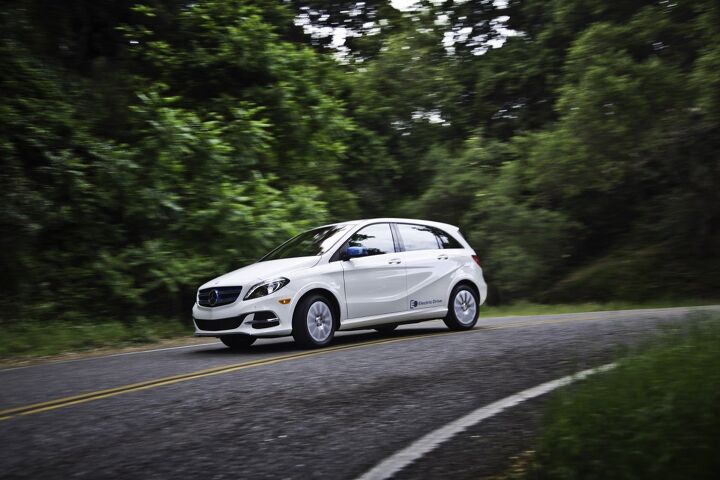The Mercedes-Benz B-Class EV Is Dead, so the B-Class Is Dead in America
Before it ever got the chance to serve a conventional role in Mercedes-Benz USA’s lineup as America’s lone premium mini-MPV, the Mercedes-Benz B-Class is dead.
Mind you, the B-Class isn’t dead globally. But the B-Class Electric Drive, the only version of the B-Class ever to make it to U.S. shores, is ending production this fall.
The Mercedes-Benz B-Class ED will be missed, if at all, by very few Americans.
According to Automotive News, Mercedes-Benz sold only 3,651 B-Class Electric Drives between December 2013 and June 2017 — fewer than 100 per month. In a world where the Nissan Leaf, even three years removed from peak popularity, averages 12 times that sort of monthly volume, the Rastatt, Germany-built B-Class ED is a whole ‘nuther kind of rare.
At first, the electric B-Class’s limited availability in California and associated ZEV states likewise limited sales potential. Eventually, however, the route causes of the B-Class ED’s low volume became obvious: the Mercedes-Benz B250e is a tall $40,895 hatchback with 87 miles of range, 177 horsepower, and wheels that declare to all around, “I can’t make it from Los Angeles to San Diego.”
Consumers appear willing to jump on the long-range electric bandwagon of a startup like Tesla for a car such as the Model 3. But the B-Class Electric Drive is one of numerous electric cars from established automakers that have failed to take off, limited in part by architecture designed for a conventional car.
The B-Class, on the market in Canada since 2005 and spanning two generations, is currently sold north of the border as the B250 and B250 4Matic, powered by the CLA’s 208-horsepower 2.0-liter turbo four. Though by no means a popular car, Mercedes-Benz Canada has sold more than 30,000 B-Classes since launching a dozen years ago. The B250 is currently priced from the USD equivalent of $30,000, a couple hundred bucks more than the basic CLA250.
South of the border, the B250e ends a run that produced the bulk of its volume in 2015, when 1,906 — more than half — of the B-Class Electric Drives were sold. Mercedes-Benz will now turn its focus to the EQ sub-brand. Automotive News says of the 10 electric cars Mercedes-Benz wants to be selling by 2022, many will be EQ-badged vehicles.
If EVs were ever going to reach Mercedes-Benz’s forecast of 25 percent global market share by 2025, the B-Class Electric Drive was not the car that was going to put them over the hump.
[Image: Daimler AG]
Timothy Cain is a contributing analyst at The Truth About Cars and Autofocus.ca and the founder and former editor of GoodCarBadCar.net. Follow on Twitter @timcaincars.
More by Timothy Cain
Latest Car Reviews
Read moreLatest Product Reviews
Read moreRecent Comments
- ToolGuy First picture: I realize that opinions vary on the height of modern trucks, but that entry door on the building is 80 inches tall and hits just below the headlights. Does anyone really believe this is reasonable?Second picture: I do not believe that is a good parking spot to be able to access the bed storage. More specifically, how do you plan to unload topsoil with the truck parked like that? Maybe you kids are taller than me.
- ToolGuy The other day I attempted to check the engine oil in one of my old embarrassing vehicles and I guess the red shop towel I used wasn't genuine Snap-on (lots of counterfeits floating around) plus my driveway isn't completely level and long story short, the engine seized 3 minutes later.No more used cars for me, and nothing but dealer service from here on in (the journalists were right).
- Doughboy Wow, Merc knocks it out of the park with their naming convention… again. /s
- Doughboy I’ve seen car bras before, but never car beards. ZZ Top would be proud.
- Bkojote Allright, actual person who knows trucks here, the article gets it a bit wrong.First off, the Maverick is not at all comparable to a Tacoma just because they're both Hybrids. Or lemme be blunt, the butch-est non-hybrid Maverick Tremor is suitable for 2/10 difficulty trails, a Trailhunter is for about 5/10 or maybe 6/10, just about the upper end of any stock vehicle you're buying from the factory. Aside from a Sasquatch Bronco or Rubicon Jeep Wrangler you're looking at something you're towing back if you want more capability (or perhaps something you /wish/ you were towing back.)Now, where the real world difference should play out is on the trail, where a lot of low speed crawling usually saps efficiency, especially when loaded to the gills. Real world MPG from a 4Runner is about 12-13mpg, So if this loaded-with-overlander-catalog Trailhunter is still pulling in the 20's - or even 18-19, that's a massive improvement.



































Comments
Join the conversation
Ugly car with mediocre performance and highest price in class - a real mystery why it wasn't super popular.
I am sure Mercedes has a long line up of men aged 50+ who want to drive something called an "ED".